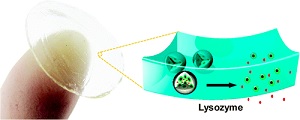 |
| Nanodiamond-embedded contact lens for sustained drug delivery--Courtesy of UCLA |
Using one of nature's simplest structures--the diamond--researchers at UCLA have developed a nanogel that can be embedded into contact lenses, with the ultimate goal of delivering glaucoma drugs to the eye over an extended period of time.
For glaucoma patients, many current treatments require multiple injections that can be uncomfortable and don't last as long as a local treatment. But the normal drug-eluting contact lens is also not a perfect solution because of the tendency to deliver unpredictable doses.
Now, bioengineers at the UCLA School of Dentistry have created a lens with a nanogel made of small diamonds that hold the glaucoma drug timolol maleate until it is released by an enzyme present in tears. This enzyme, called lysozyme, triggers the release of the drug in a way that allows the eye to retain the drug instead of letting it leak, according to an abstract in the journal ACS Nano.
"The reason we use nanodiamonds is they form uniform particles at about 5 nanometers in diameter with a unique faceted architecture resembling a truncated octohedron, like a soccer ball with sharp faces," lead author Dean Ho told FierceDrugDelivery. "These surfaces have a unique charge that binds many types of drugs and releases them slowly instead of all at once."
And what's more, the way the electrostatics work in the nanodiamond structure, the gel attracts water in ways that other drug carriers do not, Ho said, leaving the eye hydrated during the medication process.
Others have created contact lenses with drugs printed on the surface, but being able to trigger the release of the drug is a different thing. For this release mechanism, the nanodiamonds were combined with the naturally-occurring chitosan, which is similar to a polymer and can be found in the shells of crustaceans. When the lysozyme in tears breaks down this polymer-like substance, the diamond structure breaks down and releases the drug slowly in the eye.
Working with nanodiamonds for over 6 years, Ho and his team are looking at other uses as well, to treat certain types of oral cancers, for instance.
"We're interested in cancer research and moving onto preclinical validation," Ho said. "This type of nanogel isn't only for contact lens applications. It's a pretty versatile platform."
Diamonds of this type aren't very hard to come by, Ho said, as they are a byproduct of mining and refining processes in industry. With a simple cleaning process, they're readily usable for medical purposes.
"There are other options besides nanodiamonds, but what we like about the diamond is it's a naturally occurring material that's ideal for this type of use," Ho said. "We're really trying to find a good niche where the diamond can make a big impact."
- here's the abstract